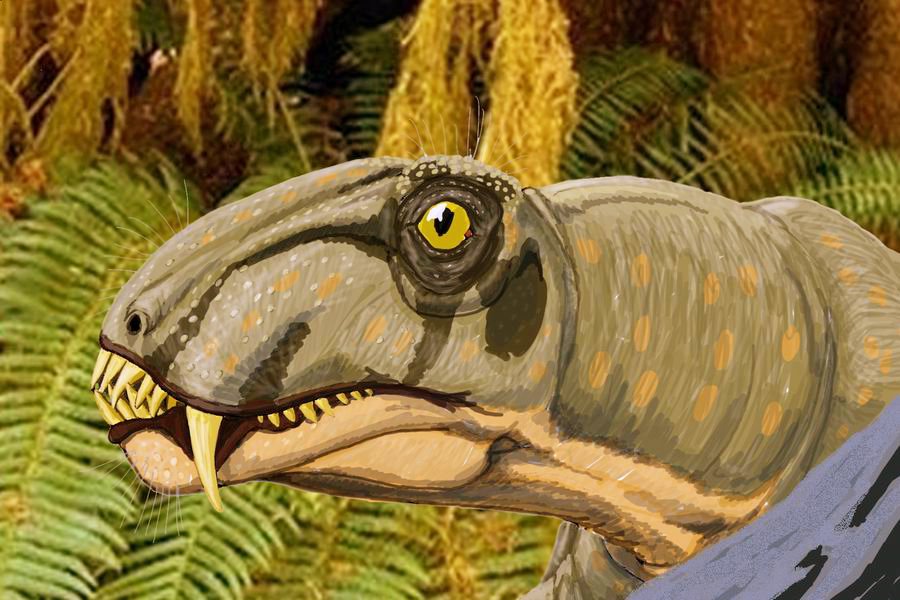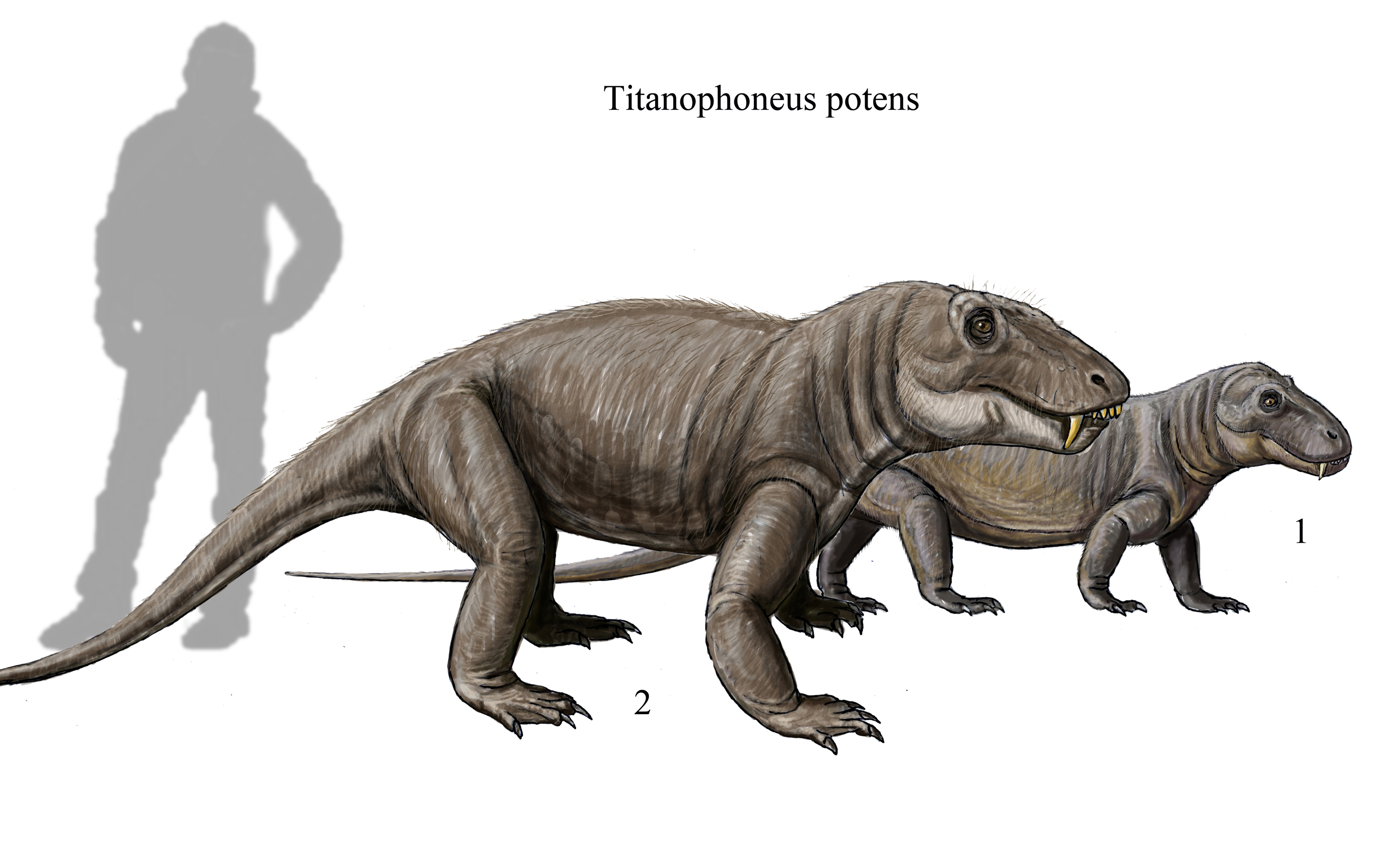|
Anakamacops
''Anakamacops'' (meaning "similar to ''Kamacops''" in Greek) is a genus of dissorophid temnospondyl from the early Middle Permian of China. It is known from the right side of a snout that was described in 1999 from the Dashankou locality of the Xidagou Formation, which is within the city of Yumen. The type species was named ''A. petrolicus'' because Yumen is an oil-producing city (petrol). More substantial material, including a partial skull and partial mandibles, was described by Liu (2018). Description ''Anakamacops'' is most similar to ''Kamacops'', sharing features such as a choana widely separated from the interpterygoid vacuities and extensive exostosis An exostosis, also known as bone spur, is the formation of new bone on the surface of a bone. Exostoses can cause chronic pain ranging from mild to debilitatingly severe, depending on the shape, size, and location of the lesion. It is most commonl ... ornamenting the skull roof. Both are large taxa; the most complete s ... [...More Info...] [...Related Items...] OR: [Wikipedia] [Google] [Baidu] |
Dissorophid
Dissorophidae is an extinct family of medium-sized, temnospondyl amphibians that flourished during the late Carboniferous and early Permian periods. The clade is known almost exclusively from North America. History of study Dissorophidae is a diverse clade that was named in 1902 by George A. Boulenger. Junior synonyms include Otocoelidae, Stegopidae, and Aspidosauridae. Early in the study of dissorophoids when the relationships of different taxa were not well-resolved and most taxa had not been described, Dissorophidae sometimes came to include taxa that are now not regarded as dissorophids and may have excluded earlier described taxa that are now regarded as dissorophids. Amphibamiforms were widely regarded as small-bodied dissorophids, and at one point, Dissorophidae was also suggested to also include Trematopidae. 19th century In 1895, American paleontologist Edward Drinker Cope named ''Dissorophus'' from the early Permian of Texas. This was the first dissorophid to be d ... [...More Info...] [...Related Items...] OR: [Wikipedia] [Google] [Baidu] |
Xidagou Formation
The Qingtoushan Formation is a Middle Permian-age geologic formation in the Qilian Mountains of Gansu, China. It is known for its diverse tetrapod fauna known as the Dashankou fauna, which likely dates to the Roadian, and includes some of the oldest known therapsids. This formation was previously erroneously named as the Xidagou Formation, a name which applies to otherwise Triassic strata in the northern Qillian Mountains. The formation is over 300 metres thick, and primarily consists of purple-red coarse sandstone Sandstone is a clastic sedimentary rock composed mainly of sand-sized (0.0625 to 2 mm) silicate grains. Sandstones comprise about 20–25% of all sedimentary rocks. Most sandstone is composed of quartz or feldspar (both silicates ...s, with minor purple mudstone.Liu J, Qinghua S, Keqin S, Lu L (2012The horizon of Dashankou Fauna and the Permo-Triassic strata in northern Qilian area, China Vertebr Palasiat 50(4):373–381 (In Chinese) Paleobiota ... [...More Info...] [...Related Items...] OR: [Wikipedia] [Google] [Baidu] |
Kamacops
''Kamacops'' is a genus of dissorophid temnospondyls known from the Middle to Late Permian of Russia that was described by Yuri Gubin in 1980. It is known from a single species, ''Kamacops acervalis,'' material of which is currently reposited in the Paleontological Institute of the Russian Academy of Sciences. ''Kamacops'' is one of the youngest dissorophids, along with '' Iratusaurus'' and '' Zygosaurus'' from Russia and ''Anakamacops'' from China and was one of the largest known dissorophids, with an estimated skull length of 24–30 cm. It is typically recovered as being most closely related to ''Zygosaurus'' and to the North American ''Cacops ''Cacops'' ("ugly look" for its strange appearance), is a genus of dissorophid temnospondyls from the Kungurian stage of the early Permian of the United States. ''Cacops'' is one of the few olsoniforms (dissorophids and the larger trematopids) ...''''.'' A detailed study of the braincase region was performed by Schoch (1999), ... [...More Info...] [...Related Items...] OR: [Wikipedia] [Google] [Baidu] |
Guadalupian
The Guadalupian is the second and middle series/epoch of the Permian. The Guadalupian was preceded by the Cisuralian and followed by the Lopingian. It is named after the Guadalupe Mountains of New Mexico and Texas, and dates between 272.95 ± 0.5 – 259.1 ± 0.4 Mya. The series saw the rise of the therapsids, a minor extinction event called Olson's Extinction and a significant mass extinction called the end-Capitanian extinction event. The Guadalupian was previously known as the Middle Permian. Name and background The Guadalupian is the second and middle series or epoch of the Permian. Previously called Middle Permian, the name of this epoch is part of a revision of Permian stratigraphy for standard global correlation. The name "Guadalupian" was first proposed in the early 1900s, and approved by the International Subcommission on Permian Stratigraphy in 1996. References to the Middle Permian still exist. The Guadalupian was preceded by the Cisuralian and followed by the Lop ... [...More Info...] [...Related Items...] OR: [Wikipedia] [Google] [Baidu] |
Broiliellus Olsoni
''Broiliellus'' is an extinct genus of dissorophoid temnospondyl within the family Dissorophidae. ''Broiliellus'' is most closely related to the genus ''Dissorophus'', and both have been placed in the subfamily Dissorophinae. ''Broiliellus'' is known from five species from the Early Permian: the type species is ''Broiliellus texensis,'' and the other species are ''Broiliellus brevis,'' ''Broiliellus olsoni, Broiliellus arroyoensis,'' and ''Broiliellus reiszi''. An additional species, ''Broiliellus novomexicanus'', which was originally named ''Aspidosaurus novomexicanus'', is now thought to fall outside the genus as a member of the subfamily Eucacopinae. History of study ''Broiliellus'' was first named by American paleontologist S.W. Williston in 1914 based on two nearly complete skulls in articulation with postcranial material from the early Permian of Texas; this species was given the name ''Broiliellus texensis'', the genus name being for the German paleontologist Ferdinand B ... [...More Info...] [...Related Items...] OR: [Wikipedia] [Google] [Baidu] |
Dissorophus Multicinctus
''Dissorophus'' (DI-soh-ROH-fus) (meaning "double roof" for two layers of armor) is an extinct genus of temnospondyl amphibian that lived during the Early Permian Period about 273 million years ago. Its fossils have been found in Texas and in Oklahoma in North America. Its heavy armor and robust build indicate ''Dissorophus'' was active on land, similar to other members of the clade Dissorophidae that are known from the Late Carboniferous to the Early Permian periods. ''Dissorphus'' is distinguished by its small body size, disproportionately large head and short trunk. The American paleontologist Edward Drinker Cope first briefly described ''Dissorophus'' in 1895,Cope. E.D. 1895. A batrachian armadillo. ''American Naturalist'' 29:99/ref> likely deriving the genus name from Ancient Greek δισσός/dissos "double" and ὀροφή/orophe "roof" to refer to the double layer of armor formed by horizontal "spinous branches" at the top of the neural spines of the vertebrae that "touc ... [...More Info...] [...Related Items...] OR: [Wikipedia] [Google] [Baidu] |
Brevidorsum
''Brevidorsum'' is an extinct genus of dissorophoidean euskelian temnospondyl within the family Dissorophidae. See also * Prehistoric amphibian * List of prehistoric amphibians This list of prehistoric amphibians is an attempt to create a comprehensive listing of all Genus, genera from the fossil record that have ever been considered to be amphibians, excluding purely vernacular terms. The list includes all commonly accep ... References Dissorophids Cisuralian temnospondyls of North America Prehistoric amphibian genera {{temnospondyli-stub ... [...More Info...] [...Related Items...] OR: [Wikipedia] [Google] [Baidu] |
Reiszerpeton Renascentis
''Reiszerpeton'' is an extinct genus of dissorophid temnospondyl known from the Early Permian Archer City Formation of Texas. It is known solely from the holotype, MCZ 1911, a complete skull. This specimen was originally referred to the amphibamiform '' Tersomius texensis''. A reappraisal of the holotype of ''T. texensis'' and a number of other referred specimens by Maddin et al. (2013) noted a number of differences from both ''T. texensis'' and amphibamiforms more broadly that suggested affinities with the Dissorophidae. This was confirmed by a phylogenetic analysis, which placed it as the sister taxon to the Eucacopinae (''Cacops'' + ''Zygosaurus'' + ''Kamacops''). ''Reiszerpeton'' is known only from the type species, ''R. renascentis'', which was named for Canadian paleontologist Robert Reisz Robert Rafael Reisz is a Canadian paleontologist and specialist in the study of early amniote and tetrapod evolution. Research career Reisz received his B.Sc. (1969), M.Sc. (1971) ... [...More Info...] [...Related Items...] OR: [Wikipedia] [Google] [Baidu] |
Conjunctio Multidens
''Conjunctio'' is an extinct genus of dissorophid temnospondyl amphibian from the early Permian of New Mexico. The type species, ''Conjunctio multidens'', was named by paleontologist Robert L. Carroll in 1964. History of study The holotype specimen was found in 1911 in the Lower Permian Abo Formation in New Mexico ) , population_demonym = New Mexican ( es, Neomexicano, Neomejicano, Nuevo Mexicano) , seat = Santa Fe , LargestCity = Albuquerque , LargestMetro = Tiguex , OfficialLang = None , Languages = English, Spanish ( New Mexican), Navajo, Ker .... It consists of the skull and postcranial material including femora, humeri, scapulae, pelvis, a section of the vertebral column, and osteoderms. It was originally described by Case et al. (1913) as a referred specimen of ''Aspidosaurus'' (sometimes "''Broiliellus''") ''novomexicanus'' but was subsequently determined to be a distinct species by Carroll (1964). Carroll also identified a third specimen of ''Conjunctio'', ... [...More Info...] [...Related Items...] OR: [Wikipedia] [Google] [Baidu] |
Eucacopinae
Eucacopinae is an extinct clade (evolutionary grouping) of dissorophid temnospondyls. Eucacopines differ from the other main group of dissorophids, the Dissorophinae, in having more lightly built skeletons and more knobby skulls. The subfamily was originally named Cacopinae, but since the name was already established for a group of living microhylid frogs in 1931, the name was changed to Eucacopinae in 2013. Eucacopinae is a stem-based taxon defined as the most inclusive clade containing the species '' Cacops apsidephorus'' but not '' Dissorophus multicinctus'', which belongs to Dissorophinae. According to the most recent phylogenetic analyses of Dissorophidae, Eucacopinae includes the basal ("primitive") species ''Conjunctio multidens'' and '' Scapanops neglecta'' from the southwestern United States and a more derived ("advanced") group including several species of ''Cacops'' (also from the southwestern United States) and the Russian genera ''Kamacops'' and '' Zygosaurus''. Der ... [...More Info...] [...Related Items...] OR: [Wikipedia] [Google] [Baidu] |
Scapanops Neglecta
''Scapanops'' is an extinct genus of dissorophid temnospondyl amphibian known from the Early Permian Nocona Formation of north-central Texas, United States. It contains only the type species ''Scapanops neglecta'', which was named by Rainer R. Schoch and Hans-Dieter Sues in 2013. ''Scapanops'' differs from other dissorophids in having a very small skull table, which means that its eye sockets are unusually close to the back of the skull. The eye sockets are also very large and spaced far apart. ''Scapanops'' was probably small-bodied (around long) with a proportionally large head and short trunk and tail. Like other dissorophids, it probably spent most of its life on land. Description The only known skull of ''Scapanops'' is long. ''Scapanops'' is distinguished from other dissorophids by five unique features or autapomorphies: a large spacing between the orbits or eye sockets, giving the skull an oval-shaped outline; a very small skull table behind the orbits; a long snout tw ... [...More Info...] [...Related Items...] OR: [Wikipedia] [Google] [Baidu] |
Broiliellus Brevis
''Broiliellus'' is an extinct genus of dissorophoid temnospondyl within the family Dissorophidae. ''Broiliellus'' is most closely related to the genus ''Dissorophus'', and both have been placed in the subfamily Dissorophinae. ''Broiliellus'' is known from five species from the Early Permian: the type species is ''Broiliellus texensis,'' and the other species are ''Broiliellus brevis,'' ''Broiliellus olsoni, Broiliellus arroyoensis,'' and ''Broiliellus reiszi''. An additional species, ''Broiliellus novomexicanus'', which was originally named ''Aspidosaurus novomexicanus'', is now thought to fall outside the genus as a member of the subfamily Eucacopinae. History of study ''Broiliellus'' was first named by American paleontologist S.W. Williston in 1914 based on two nearly complete skulls in articulation with postcranial material from the early Permian of Texas; this species was given the name ''Broiliellus texensis'', the genus name being for the German paleontologist Ferdinand B ... [...More Info...] [...Related Items...] OR: [Wikipedia] [Google] [Baidu] |


